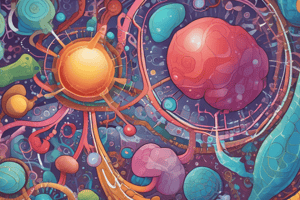Podcast
Questions and Answers
What is the primary role of ATP within a cell?
What is the primary role of ATP within a cell?
- To break down glucose molecules.
- To transport oxygen to cells.
- To remove waste products from cells.
- To store energy for cellular processes. (correct)
Which of the following is a direct product of glycolysis?
Which of the following is a direct product of glycolysis?
- Pyruvate (correct)
- Oxygen
- Glucose
- Carbon dioxide
In what part of the cell does glycolysis take place?
In what part of the cell does glycolysis take place?
- Nucleus
- Intermembrane space
- Cytoplasm (correct)
- Mitochondrial matrix
What is the role of NADH and FADH2 in cellular respiration?
What is the role of NADH and FADH2 in cellular respiration?
What is the main purpose of cellular respiration?
What is the main purpose of cellular respiration?
Which component of the mitochondria houses the electron transport chain?
Which component of the mitochondria houses the electron transport chain?
What key process occurs in the matrix of the mitochondria?
What key process occurs in the matrix of the mitochondria?
What is the chemical formula for glucose?
What is the chemical formula for glucose?
What happens during the hydrolysis of ATP?
What happens during the hydrolysis of ATP?
How many net ATP molecules are produced during glycolysis?
How many net ATP molecules are produced during glycolysis?
What is produced by the Krebs cycle?
What is produced by the Krebs cycle?
What Role does Glucose have in Cellular Respiration?
What Role does Glucose have in Cellular Respiration?
What increases the surface area for ATP synthesis within the mitochondria?
What increases the surface area for ATP synthesis within the mitochondria?
In the Krebs Cycle, what happens to pyruvate?
In the Krebs Cycle, what happens to pyruvate?
What is transferred from Glycolysis to the Krebs Cycle?
What is transferred from Glycolysis to the Krebs Cycle?
Where does the Krebs Cycle occur?
Where does the Krebs Cycle occur?
How many CO2 molecules are produced as waste in the Krebs Cycle?
How many CO2 molecules are produced as waste in the Krebs Cycle?
How many ATP molecules per pyruvate molecule are produced by the Krebs Cycle?
How many ATP molecules per pyruvate molecule are produced by the Krebs Cycle?
How many NADH and FADH2 are produced per pyruvate molecule during the Krebs Cycle?
How many NADH and FADH2 are produced per pyruvate molecule during the Krebs Cycle?
The Krebs cycle helps in completing what?
The Krebs cycle helps in completing what?
Flashcards
What is Glucose?
What is Glucose?
It is a simple carbohydrate essential for cellular energy; a six-carbon sugar (C6H12O6) converted into energy via metabolic pathways.
What is ATP?
What is ATP?
The energy currency of the cell where energy is stored for cellular processes and releases energy during hydrolysis.
Purpose of Cellular Respiration
Purpose of Cellular Respiration
Transforms glucose into ATP (energy currency) to fuel various cellular activities.
Mitochondria
Mitochondria
Signup and view all the flashcards
What is Glycolysis?
What is Glycolysis?
Signup and view all the flashcards
Krebs Cycle (Citric Acid Cycle)
Krebs Cycle (Citric Acid Cycle)
Signup and view all the flashcards
Study Notes
- Lab 8 is about Cellular Respiration
- TA is Jayden Hume
- Office hours are Monday and Friday from 10-11am
Housekeeping
- Midterm grades have been released
- Everyone got 5 extra credit points on the midterm
- Midterm question clear up
- Extra credit opportunities are still available
- There will be a quiz next week
Introduction to Cellular Respiration
- Glucose is a simple carbohydrate which is essential for cellular energy
- It's a six-carbon sugar (C6H12O6)
- It is converted into energy via metabolic pathways
- It serves as the primary energy source for cells
- Adenosine Triphosphate (ATP) serves as the energy currency of the cell
- It functions as a crucial molecule that stores energy for cellular processes
- ATP releases energy during hydrolysis through the breaking of phosphate bonds
Purpose of Cellular Respiration
- Cellular respiration transforms glucose into ATP, which serves as the energy currency of cells
- This process is essential for fueling various cellular activities
- The inner membrane of the mitochondria houses the electron transport chain (ETC), crucial for ATP production
- Cristae extensions increase the surface area available for ATP synthesis
- The matrix is the site of the Krebs Cycle and contains mitochondrial DNA
- The intermembrane space creates a proton gradient essential for ATP synthesis
Stages of Cellular Respiration
- Glycolysis is the first stage of cellular respiration that takes place in the cytoplasm
- It transforms one glucose molecule into two pyruvate molecules
- During glycolysis, a net gain of two ATP molecules is produced
- Additionally, two NADH molecules are generated during the process
- Glycolysis occurs in the cytoplasm of the cell
- It produces 2 ATP, providing energy for cellular functions
- The process generates 2 NADH molecules, which act as electron carriers
- Additionally, 2 Pyruvate molecules are formed, crucial for subsequent stages of cellular respiration
- Overall, glycolysis is a foundational step in energy transformation within the cell
- The Krebs Cycle, also known as the Citric Acid Cycle, takes place in the mitochondria (matrix)
- It converts pyruvate into carbon dioxide as a key metabolic step and is also a rate limiting step
- During this process, ATP is produced, providing immediate energy
- NADH and FADH2 are generated, serving as vital energy carriers
- The Krebs Cycle completes the breakdown of glucose and collects electrons for the next stage
- The Krebs cycle occurs in the mitochondrial matrix
- It produces 2 CO2 molecules as waste
- The cycle generates 2 ATP as usable energy, producing 3 NADH and 1 FADH2 also produced during the cycle
- This is per 1 pyruvate molecule
Studying That Suits You
Use AI to generate personalized quizzes and flashcards to suit your learning preferences.




